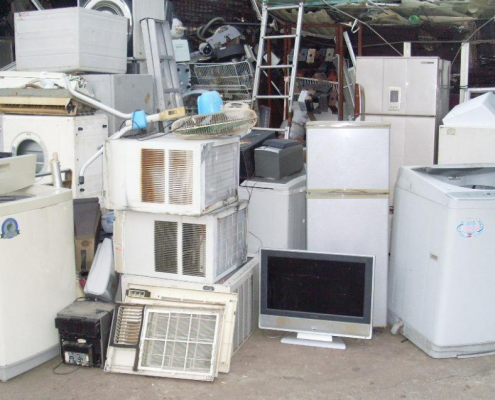In today’s society, people are enjoying comfortable living services and convenient lifestyles. And the dangers that surround us are diverse. Most of the dangers are derived from solid waste and hazardous waste.
Hazardous waste includes two meanings. One is that hazardous waste is a part of solid waste. The other is that hazardous waste must have hazardous properties. There are five common characteristics of hazardous waste, which are toxic, corrosive, flammable and infectious Chemical solids, solid wastes with one or more hazardous properties are hazardous wastes. The most common types of hazardous waste in our daily lives are the following 7 types.
1. Abandoned TV sets, refrigerators, air conditioners, washing machines, computers:
Commonly known as “four machines and one brain”, it belongs to solid waste, waste electrical and electronic products, not hazardous waste. Other electronic wastes, such as discarded mobile phones, iPads, domestic water heaters, microwave ovens, telephones, and other electronic products, are also not hazardous wastes. However, the lead glass, circuit board, compressor, separately collected refrigerant, waste fluorescent powder, waste motor, etc. separated from the waste “four machines and one brain” and other electronic wastes are hazardous wastes, and the waste categories are hw08, hw29, hw31 and hw49 respectively.
2. Button batteries, fluorescent tubes, waste drugs, waste thermometers, sphygmomanometers, etc. produced in daily life of residents:
It belongs to hazardous waste (included in hazardous waste management in classified management of domestic waste). However, according to the list of exemption management of hazardous wastes (2016 Edition), this kind of waste is included in the scope of exemption management at this stage because it comes from the daily life of residents, with small amount, large scope and high management cost.

3. Oily waste fabric, clothing, gloves, cotton yarn mixed with domestic garbage:
It belongs to hazardous waste. However, according to the list of exemption management of hazardous wastes (2016 version), such wastes are included in the exemption management scope because they are also from the daily life of residents. However, there is a situation that needs special explanation. If the enterprises in the mechanical processing and vehicle maintenance industries intentionally throw hazardous wastes such as fabrics, gloves, cotton yarn, etc. containing waste mineral oil into domestic garbage, it belongs to the situation of mixing hazardous wastes into non hazardous waste storage. According to Article 75 of the law of the people’s Republic of China on the prevention and control of environmental pollution by solid wastes, it can be rectified within a time limit And the implementation of administrative penalties.
4. Sludge from domestic sewage treatment plant:
It belongs to solid waste and does not belong to hazardous waste. According to HBO [2010] No. 157 document, in the process of transfer management of this kind of waste, “refer to hazardous waste management, establish sludge transfer joint sheet system.” According to the meaning of hazardous waste management, this kind of sludge does not belong to hazardous waste, but it is necessary to improve the management level, especially to strengthen the management of standing book, so as to prevent leakage and illegal dumping during transportation. However, the sludge produced in the sewage treatment process of industrial enterprises often belongs to the category of hazardous waste due to its leaching toxicity exceeding the standard, or containing other toxic and harmful substances and other hazardous characteristics (the determination method is mainly based on the enterprise environmental assessment, industry rules, source of materials, expert identification, attribute identification, etc.).
5. Fly ash from domestic waste incineration:
It belongs to hazardous waste (hw18). However, after meeting the requirements of article 6.3 of the standard for pollution control of domestic waste landfill (gb16889-2008), entering the domestic waste landfill for landfill is not included in the hazardous waste management; another situation is that if the requirements of the standard for pollution control of collaborative disposal of solid waste by cement kiln (gb30485-2013) are met after pretreatment, the collaborative disposal process is also included in the exemption pipe Rational category.
6. Scrapped cars, battery cars and new energy vehicles:
It belongs to solid waste and does not belong to hazardous waste. However, the following wastes generated in the automobile disassembly and maintenance industry are classified as hazardous wastes after being collected separately: waste battery, waste machine oil drum (kettle, filter element), waste engine oil, waste circuit board, waste exhaust gas purification catalyst (commonly known as ternary multi effect catalyst), unexploded safety airbag, oil-containing gloves (fabric, clothing, etc.), and the waste categories are hw08, hw15, hw49, hw50 respectively and so on.
7. Sludge produced in sewage treatment process of medical institutions:
Most of them are hazardous wastes. According to the regulations on the management of medical wastes (Order No. 380 of the State Council), “medical wastes refer to the wastes with direct or indirect infectivity, toxicity and other hazards produced by medical and health institutions in medical treatment, prevention, health care and other related activities.” According to the national list of hazardous wastes, “medical waste belongs to hazardous waste. The classification of medical waste shall be carried out in accordance with the catalogue of classification of medical waste. ” The “infectious waste” in the catalogue of medical waste classification (WYF [2003] No. 287) includes “other articles polluted by the patient’s blood, body fluid and excreta”. The grid slag, sedimentation sludge and septic tank sludge produced in the sewage treatment process of medical institutions should be included in this category.
If a medical institution has specially designed the wastewater treatment process during the environmental impact assessment, and has made the attribute judgment for the sludge, if the management department thinks that this kind of sludge should be included in the hazardous waste management, it should make the final judgment through the hazardous waste identification procedure.


